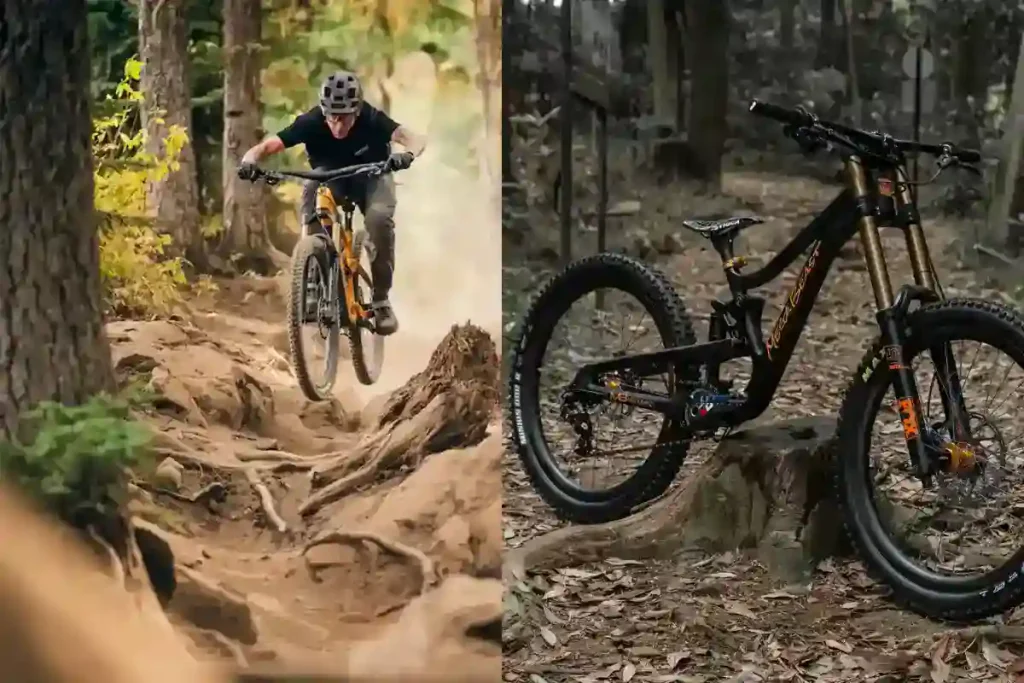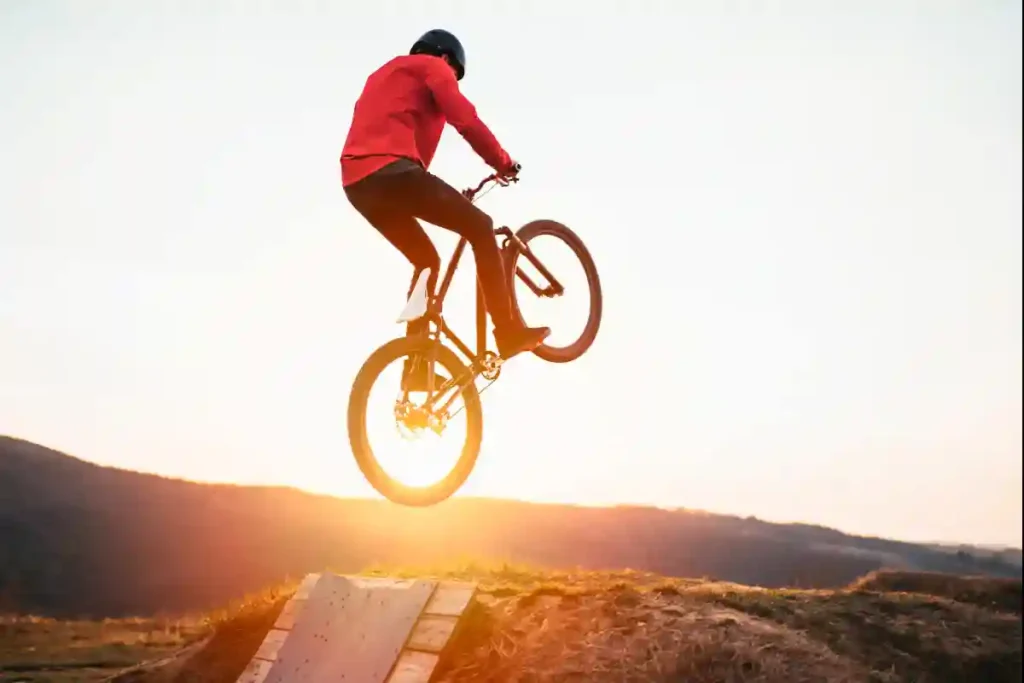Yes, you can ride a downhill bike on trails. However, while downhill bikes are designed for steep descents and rough terrain, they might not be the most ideal for trail riding due to their specialized features like heavy-duty suspension and geometry. Some riders still use them on trails, but their efficiency may vary depending on the specific trail and riding style.
Downhill Bikes on Trails: A Feasibility Check
Delving into the realm of mountain biking, the discourse often circles back to a pivotal query: Can downhill bikes traverse various trails effectively? In this comprehensive guide, we unravel the intricacies surrounding the plausibility of using downhill bikes on diverse trails, examining their advantages, drawbacks, and adaptability.
Pros and Cons of Using Downhill Bikes on Trails

Pros
Speed & Stability: Downhill bikes are engineered for breakneck speeds and unwavering stability, ideal for conquering steep descents and intricate trail sections. These specialized bikes empower riders with supreme control and confidence, ensuring a thrilling yet secure ride experience.
Precision & Performance: With a focus on precision handling, downhill bikes elevate performance levels on downhill tracks. Their design fosters superior traction, enabling riders to navigate challenging landscapes with finesse.
Safety Features: Equipped with cutting-edge braking systems and resilient components, downhill bikes prioritize safety during swift descents. This enables riders to tackle obstacles with heightened assurance and security.
Cons
Weight & Maneuverability: The substantial weight of downhill bikes might hinder nimbleness on flatter or uphill trails, necessitating additional rider effort. Negotiating tight corners could pose challenges owing to the bike’s heftiness.
Limited Versatility: While excelling in steep and technical descents, downhill bikes might exhibit limitations on smoother or less aggressive trails. Their specialized design restricts adaptability to diverse terrains, potentially impacting overall performance.
Maintenance & Cost: Maintenance demands and expenses associated with servicing downhill bikes can be higher due to their specialized components and frequent wear from aggressive riding styles.
Read more: Is Downhill Mountain Biking Good Exercise?
How Downhill Bikes Handle Different Trail Terrains
Understanding the terrain dynamics sheds light on how downhill bikes excel
Steep Descents: Downhill bikes thrive on steep and rugged descents, leveraging their robust build and suspension for agile and stable navigation through challenging terrain.
Technical Tracks: Trails featuring drops, jumps, and rough terrain align perfectly with the capabilities of downhill bikes, allowing riders to exploit their superior control and traction effectively.
Smooth or Flatter Trails: Conversely, on smoother or less aggressive trails, the design of downhill bikes may limit their efficiency and agility, making them less optimal for such terrains.
Uphill or Cross-Country Trails: Due to their weight and specialized design, uphill rides or long-distance cross-country trails might not align with the strengths of downhill bikes, necessitating a lighter and more versatile bike setup for optimal performance.
Comparing Downhill Bikes with Trail-Specific Bikes

In the world of mountain biking, choosing between a downhill bike and a trail-specific bike can be a pivotal decision for riders seeking thrilling adventures. Let’s dive into a detailed comparison to illuminate the distinctive features of these specialized bikes.
Downhill Bikes vs. Trail-Specific Bikes: Unveiling the Differences
Downhill Bikes
Crafted for Adrenaline: Tailored for high-octane descents, downhill bikes feature sturdy frames and extensive suspension, ensuring maximum speed and control on steep, technical trails.
Specialized Components: Equipped with heavy-duty brakes and wider tires, these bikes excel in tackling challenging terrains. However, their weight may affect maneuverability on flatter or uphill sections.
Versatility Limitation: While excelling on descents, the specialized design of downhill bikes might restrict adaptability on less aggressive trails, making them less versatile across various terrains.
Trail-Specific Bikes:
Versatility Champion: Engineered for balanced performance, trail-specific bikes strike a harmonious blend between uphill and downhill capabilities. Their moderate suspension and lighter frame adapt well to diverse terrains.
Adaptability Edge: These bikes handle technical trails while offering agility on smoother paths, catering to riders seeking versatility across different trail types.
Efficiency in Climbing: Compared to downhill bikes, trail-specific ones are more efficient climbers due to their lighter build and design that cater to both uphill and downhill prowess.
Choosing the Right Downhill Bike for Trail Riding
Selecting the perfect downhill bike for trail riding requires a strategic approach
Terrain Analysis: Evaluate the predominant trail types you intend to ride. Opt for a downhill bike if steep descents dominate, but consider a versatile trail-specific bike for varied terrains.
Test Rides Count: Visit bike shops or rental centers to test ride different models. Assess their performance across terrains to align with your riding style and trail preferences.
Financial and Maintenance Insights: Factor in initial costs and ongoing maintenance expenses. Downhill bikes, with specialized components, might incur higher maintenance expenditures.
Tips for Trail Riding with a Downhill Bike

Effectively maneuvering downhill bikes on trails involves specific strategies:
Technique Mastery: Utilize the bike’s stability and suspension by mastering body positioning and weight distribution for enhanced control and traction on challenging descents.
Adapting Riding Style: Navigate corners and flatter sections while being mindful of the bike’s weight. Plan lines strategically and utilize momentum to negotiate technical spots efficiently.
Regular Maintenance Routine: Due to rigorous usage on demanding terrains, prioritize regular servicing. Check brakes, suspension, and tire pressure regularly for optimal performance and safety.
Read more: What is Downhill Mountain Biking? The History of Downhill Biking
Challenges of Riding Downhill Bikes on Trails
Riding downhill bikes along trails presents an intriguing blend of exhilaration and hurdles that demand adeptness and adaptability from riders. These challenges, intricately linked to the bike’s specialized nature and the demands of the trails, create a unique experience for enthusiasts.
Navigating Technical Terrain: Maneuvering through technical trails necessitates precision. Negotiating obstacles like rocks and roots requires refined skills in handling challenging terrains.
Traction Challenges on Loose Ground: Grappling with loose or slippery ground poses traction challenges for downhill bikes. Achieving a delicate balance between control and agility is crucial to maintaining stability.
Skill Mastery and Endurance: Conquering downhill trails demands both technical prowess and endurance. The bike’s weight and the rigorous nature of these terrains necessitate physical and mental fortitude.
Understanding Downhill Bike Performance on Trails

The performance of downhill bikes is a tale of contrasts, excelling in some aspects while facing limitations in others.
Advantages in Steep Descents: These bikes excel on steep descents and technical sections, providing riders with unparalleled stability and control, and enhancing their riding experience.
Limitations on Less Aggressive Trails: However, their specialized design might pose challenges on flatter or less aggressive trails, impacting versatility and maneuverability, and prompting riders to adapt.
Improving Trail Riding Skills with a Downhill Bike
Enhancing trail riding skills through downhill biking involves refining skills and adaptability.
Skill Development Opportunity: Riding downhill bikes on trails refines riding skills, emphasizing body positioning and balance, and fostering a deeper connection between rider and bike.
Adaptability as Essential: Learning to adapt techniques to diverse terrains empowers riders, enabling effective handling of downhill bikes on varied trails, and boosting overall riding proficiency.
Read more: Are Downhill Bikes Good For Jumping?
Conclusion: Can You Ride a Downhill Bike on Trails?
Riding a downhill bike on trails is indeed possible, offering an exhilarating yet challenging experience. Overcoming these challenges by refining skills and understanding the bike’s dynamics on diverse terrains is crucial for an enjoyable and safe downhill biking adventure.

